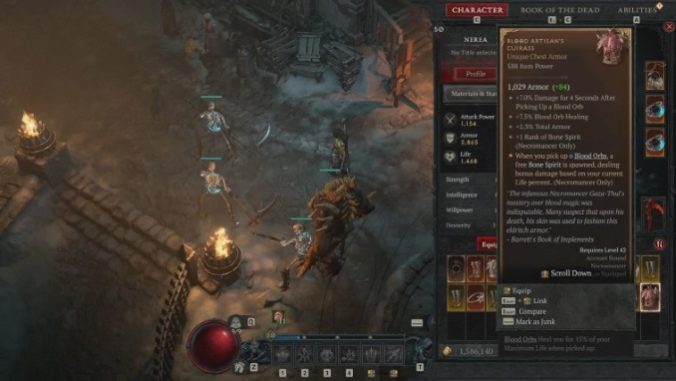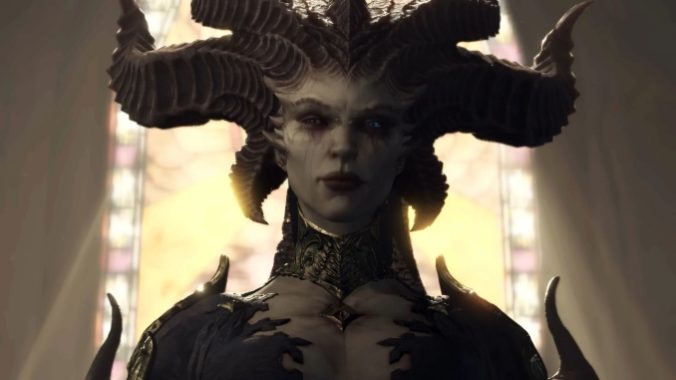Diablo always begins in a town, whether it’s Tristram, the Rogue Encampment, or New Tristram (conveniently located on the outskirts of a largely obliterated Old Tristram). Towns have a long history in dungeon crawling. From the earliest tabletop adventures to the most recent Final Fantasy, in my mind, the best dungeon crawlers always have towns. Whether it’s Wizardry (the progenitor of Dragon Quest, et al.) or The Dungeons of Moria (which directly ties into the creation of Diablo), my takeaway from a lifetime of dungeon crawlers is this: a dungeon is only as good as the town it menaces.
Tristram was a triumph in that regard, elevating a bog standard solo adventure from a grim fantasy dungeon loop into a tidy, compact cosmic horror story about a backwater town and the primeval doom just below its surface, and all the weirdos that lived there. It’s a vision of the fortitude and precarity of civilization. We enter Tristram as an outsider, and come to see it as a refuge, a bulwark, and ultimately doomed despite our best efforts.
Diablo IV presents us with that town, offering us warmth and salvation in a blizzard. And then it immediately kicks the chair out from under us with bloodthirsty cultists. It fucking rules, until it doesn’t.
Despite all its grand setup with a tense cinematic featuring the blood and tissue arrival of Mephisto’s daughter Lilith, the emergence of a weird pale Sith Lord-looking motherfucker to a town corrupted and hostile, Diablo IV can’t hold onto the promise of either its narrative and thematic setup, or its history as a franchise. Diablo IV plays at subverting the town, only to blow apart the premise by giving us an expansive world littered with towns, encampments, and cities. Rather than trusting us with metaphor and miniature, Diablo IV has to show us an entire world at stake, as though we won’t believe that it’s there if it doesn’t. And from the small town where I’d held a glimmer of hope we’d spend the entire game, we’re rushed off to the first capital city of Kyovashad.
I can’t tell you the name of a single person in Kyovashad. There’s a blacksmith and a jeweler, a mystic enchanter who deals in “Aspects” (the bankable, transposable augmentations that make weapons and armor legendary), a horse vendor, and then the Old Gachapon Crone, who for fistfuls of Murmuring Obols (a fake currency with a name far too compelling for how uninteresting it is as a resource) will let you gamble on drawing powerful items or meltable fodder. An alchemist will let you expand the utility of your health flasks in exchange for materials (one early tier will take either luck on rare boss spawns or luck in grinding werewolves—it sucks) or craft elixirs for temporary percentage bonuses to add to all your other percentage bonuses. In every other capital city there are more just like them with different names that I don’t and won’t remember. They occupy different arrangements, on different side streets. The most detail I’ve held on to these NPCs is that one blacksmith hangs out with a tribe of Barbarians on the outskirts of the sprawling salt flat trading city of Ked Bardu—a refuge against bandits and cannibals. Towns that dot the truly colossal map of Sanctuary feature different assortments of each trade NPC. Some have alchemists and not blacksmiths. Others just have a blacksmith, and so on. All with names. None with personality.

As much as Diablo IV tries to impress upon me the grandeur and totality of the world of Sanctuary in a bid to show me what’s truly at stake, I just simply cannot care about it at all. All of a sudden Diablo has a world map. Five capital cities (to say nothing of the towns, villages, settlements, encampments, and other loose conglomerations of peoples and structures). It has discoverable waypoints and god knows how many dungeons because the map is so colossal even after finishing the campaign only half of it is uncovered for me. Sanctuary is massive and hints at an even more massive continent. It’s too big, too much, cramped and diffuse simultaneously. Diablo IV’s vision of Sanctuary has nothing to hold onto because it has traded in Diablo’s intimacy for the raw massiveness of busywork.
It all makes me very tired, and I miss my crew from Diablo III: Haedric Eamon, Miriam, Covetous Shen, and Wirt—I mean, Squirt. I miss Tristram. There’s no need for a Deckard Cain anymore because the instant you pick up a magic item, it’s automatically identified for you. Rather than an entire story for Pepin the Healer, there’s dozens of red-liquid soup pots being attended to by nobodies—you click on them, you heal and your potions refill. Vendors have clocks that indicate when their merchandise flips over. Where once the mechanics and obvious buttons of Diablo’s systems were veiled by layers of dense illusion, now it’s been stretched thin in an attempt to cover the entire world. And even this massive world is larger than its borders, because gone are the distinctions between public and private games. There is only the persistent, permanently connected world full of other players named things like BUNGHOLE.
Diablo IV makes the idea of Sanctuary into less of a real world full of towns and people and more a monstrous theme park where innumerable unmemorable towns are in a state of constant terror alert from Frankensteined dungeon bits and a pastiche of world events and repeat performances by random ghosts. Where the cash shop beckons from every menu bar, with a persistent icon letting me know something new has happened to check out what I can spend real money on with an urgency even Claudia Black’s incessant prattling in Destiny can’t match. Diablo IV turns Sanctuary into Disney World, and while the developers may be hard at work tuning the rides and attractions to play better and be more fun, the C-suite and shareholders are going to make sure it’s only going to get worse from here. That’s what we get from Games as a Service.
Ask me how I feel about the game at the conclusion of its five-to-10 hour campaign and you’ll get a different answer than if you asked me a dozen hours into spending hundreds of thousands of gold trying to find a workable post-campaign build. If you ask me after I’ve run through a number of endgame dungeons and events with friends, you’ll get another much more enthusiastic answer entirely.
And then, of course, god only knows what’s in store for Diablo long term. Its closest relative is Destiny, a game (we’re counting both as one here) that has enjoyed meteoric highs and devastating lows over the past decade as it churns over development staff and design directives, something Blizzard is also no stranger to. Diablo IV is already different from when I first started playing it for review. Where will the future take Diablo IV?
Will Diablo IV just become The Diablo we play in perpetuity? In 20 years will we be celebrating yet another season, an expansion, and new cash shop gacha pulls to mollify us as an increasingly impish Bobby Kotick prepares to flee a devastated Earth on the latest Muskian Billionaire Death Trap? Will we stop long enough from grinding successive waves of procgen dungeon trash in Tier 666 to catch a glimpse of what some will call a meteor cascading in a glorious fireball across the night sky? Will the towns still have names? Because I don’t even know them now.
Diablo IV was developed and published by Blizzard. Our review is based on the Xbox Series X|S version. It is also available for PC, Xbox Series One, PlayStation 4, and PlayStation 5.
Dia Lacina is a queer indigenous writer and photographer. She tweets too much at @dialacina.

